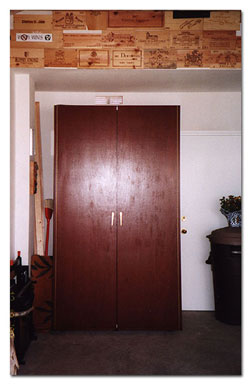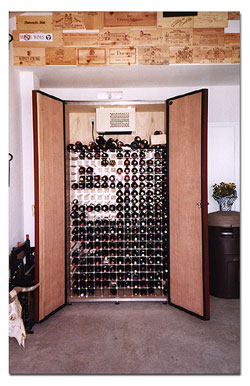|
|
The
Purchase, Care and Feeding of a Home Wine Storage Unit -
Nov
3, 1999 -
A
little background: For years I've kept my wine in my home,
rather than renting a storage locker. I usually created a "cellar"
in the house by slightly remolding a hall closet, adding racks
and bins to the walls (closet 1, closet
2). Since these were less-than-ideal conditions for wine storage,
I always knew that one day I'd need/want to put my wine into a
rental locker or buy a wine storage unit for home. Moving our
residence was the motivation to actually do something about it.
While in the process of moving, I decided to put my bottles into
a storage locker (Wine Cellar Club)
for safe keeping, while I made a final decision.
Define
Your Needs - Pick Your Options - Watch Your Step
Meanwhile,
I researched the available brands of home storage units on the
market: Vinotheque, Vinotemp, Le Cache, Eurocave, etc., and decided
that since the unit would need to go in the garage, a high-end
piece of cabinetry wasn't necessary. After pricing the available
units, I determined that Vinotemp had the best price-per-bottle
ratio. Next, I needed to decide what size unit to get.
The
size of my wine collection has remained fairly constant at around
360 bottles or so. But, concerned about under estimating my needs
and buying something too small, I finally selected a Vinotemp
600-E. The unit came with black metal racking, 19 rows with 14
slots each row. Since the bottles store two-deep, I would have
a 532 bottle storage capacity in the individual racks, along with
additional "open" storage on the upper rack for magnums and such.
I priced the unit at the local wine stores versus the factory,
and found the wine stores to be the least expensive (I presume
this is because the factory doesn't want to compete with its distributors).
At additional cost, I swapped out the black metal racking for
redwood racking, added a heavy-duty compressor and a door lock,
and had them finish the mahogany exterior of the unit.
Unfortunately,
the racking I received was not in fact "redwood." Rather,
it was something called "California wood racking," a
matrix of wood and aluminum. I was disappointed - largely for
asthetic reasons, since I thought I was completely eliminating
metal for wood. But I was also disappointed because, after researching
the racking issue a great deal, it turned out that the full redwood
racking was apparently only available to those who ordered directly
from the factory. So, the factory had two racking options available,
while the distributors only have the one. Adding insult to injury,
the distributors are charged the "redwood" price for
the less expensive racking.
|
Placement
Can Be Crucial
After
about six months in cold storage at a local wine locker
place, I brought everything back to the house and started
stocking the newly acquired Vinotemp
600-E. Of course, this was not without one small problem.
I
had planned to put the unit in a corner of my garage, and
even had the electrical outlet converted from a GFI circuit
to a regular circuit in order to reduce the risk of an electrical
shutoff. I positioned the Vinotemp exactly where I wanted
it, glued some plastic letters and numbers on the ends of
the racking as an indexing system, and then went to town
filling the holes with bottles. I started with the right
side, since the doors overlap each other and the right-hand
door needs to be opened first. After I'd finished loading
the right side, I pulled the upper and lower locking pins
on the left door, opened and swung it around to start loading
the left side. That's when I realized I'd overlooked something
... something fairly important.
As
it happens, the door(s) of the unit need to swing out nearly
180-degrees for complete loading. Otherwise, you
can't get bottles into the outside columns between the cabinet
wall and the racking. But unfortunately, the left-hand door
would not swing out far enough without hitting the wall,
meaning the cabinet needed to be moved about six more inches
to the right. (I should have remembered that old model-building
instruction: "Make sure parts fit BEFORE applying
glue.") |
 |
|
|
|
Now
I was facing a really unpleasant decision -- just forget
about using the far left column, or move the unit over a
bit to the right so I could open the door. Well, it wasn't
going to be possible to push or pull this partially-loaded
monster the required distance. And, I certainly wasn't willing
to abandon the potential storage space for 40 bottles of
wine. So, I ended up unloading nearly the entire 20 cases
from the right side of the unit, before pushing the Vinotemp
several inches to the right. Then I got the privilege of
reloading all that wine. Of course, it's not just the unloading
and re-loading that's difficult -- I'm also keeping an inventory.
So, all of the bottles need to go back into the correct
slots. Then, since the concrete slab of the garage is a
bit irregular, I needed to re-adjust the leg levelers to
balance the doors.
One
other thing I discovered: the depth of the unit and the
dimensions of the racking are not conducive to many of today's
wine bottle sizes. Frequently, taller bottles will not fit
end-to-end in the two-deep slots and still allow the door
to close. Other times, the bottle will be too fat, and have
to be stored in the upper open area. I'm sure there may
have been some custom-sized racking options available from
Vinotemp which would have helped solve the fat-bottle problem.
But, there wasn't anything I could do about the depth problem,
other than to alternate bottles of various heights into
each of the slots, to be sure that everything cleared the doors.
Another small thing. Because of the overlapping door design, the door jamb of the left-hand door protrudes inward (compensating for the cutaway portion on the outside that receives the overlapping right-hand door). This effectively reduces even further the size of bottles that will fit into that particular column.
Finally
finished, I stood back and admired the cellar. What a thing
of beauty; I've got to get more wine, I'm sure I must have
said to myself.
|

|
March
15, 2000 -
Something
interesting was beginning to develop. Since the doors of
the unit overlap, I tended to favor loading the unit primarily
on the right side, then secondarily on the left side. I
also deferred loading bottles into the far left-hand column,
just because it was the tightest angle at inserting/removing
bottles. Well, to my dismay the racking and contents in
the bottom 1/3 of the unit were beginning to shift to the
left (slightly evident in the picture above). Now obvious,
was the fact that all that downward weight on the racking
caused it to shift to the unbalanced side. Well, I figured
I could just move some bottles over to fill the left-hand
column and balance the load - no problem. Nope! The shifting
had actually squeezed down the slot size, so now I wasn't
able to insert any bottles. So, guess what? Yep, yet another
unscheduled unloading of cases and cases of wine. Interestingly,
with most of the bottles from the upper rows removed, the
racking actually sprang back to its original shape, and
the reloading began. Sigh, seat-of-the-pants engineering.
October
25, 2000 -
It
appears that the left-hand door is getting harder to close
tightly -- at least enough so that the locking pins at the
top and bottom of the door can be slid into the bracket
holes. Also, the right-hand door doesn't seem to be adjusted
correctly, being a little lower at the bottom where the
two doors meet. Because of this, the seal is leaking a little
air (which I can feel with my hand, when the compressor
is running). This all seems kind of weird, since I really
haven't done anything to the unit since March. I'm guessing
that the house/slab is settling a bit, thus throwing off
the alignment of the unit. So, I re-adjusted the levelers
again, and presto, everything was back in balance. |
| |
|
Things
get Interesting - See Part
2
|
|
|



